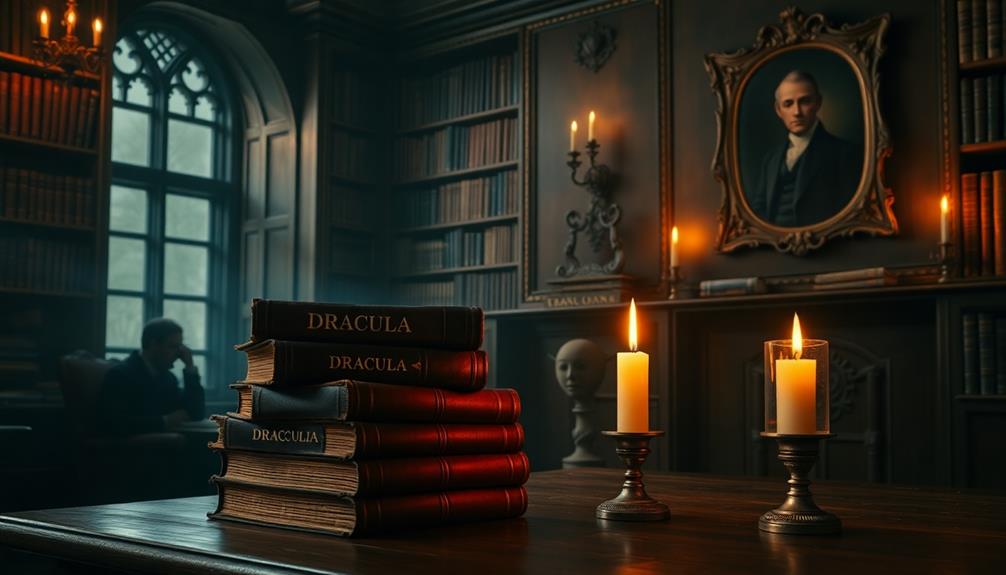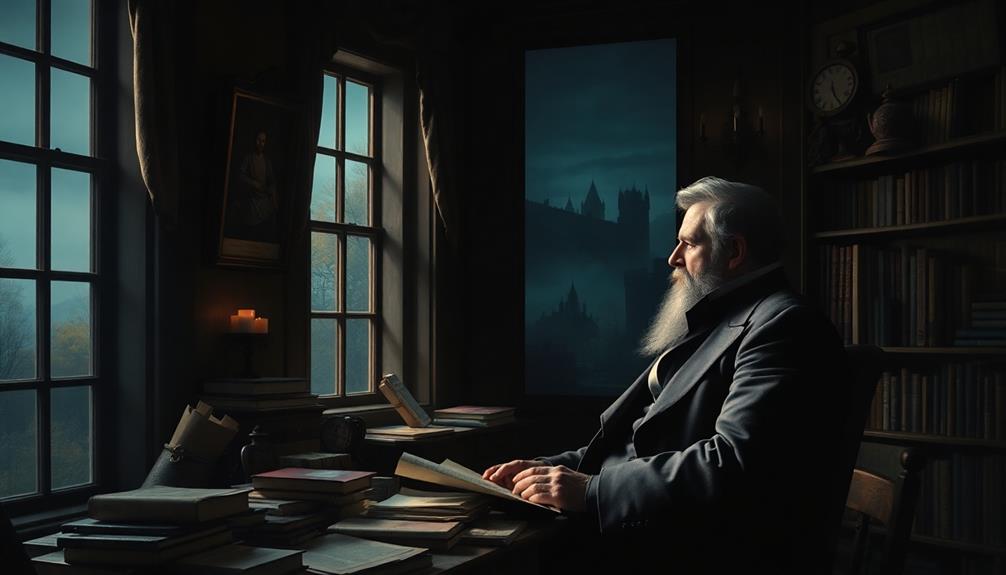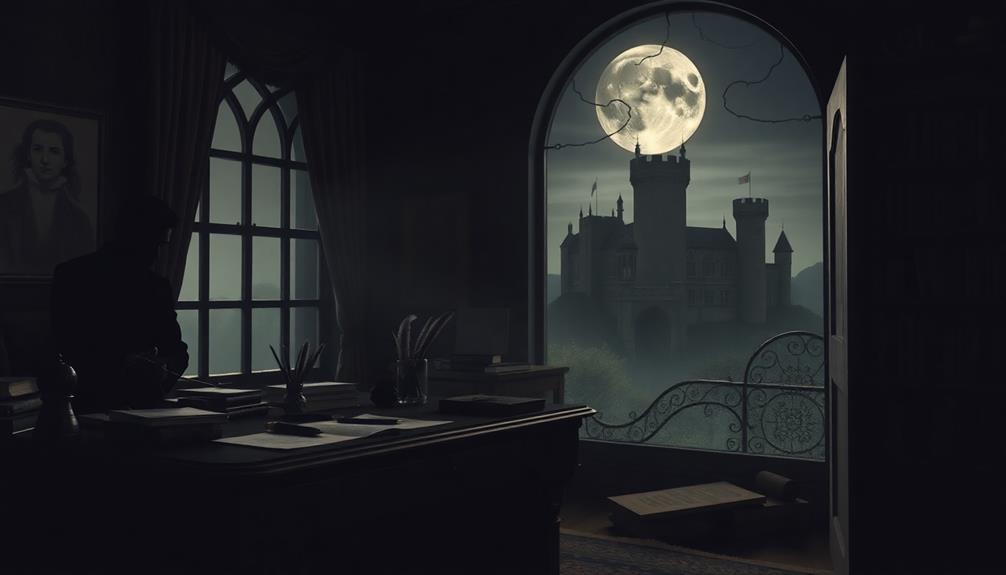You may know Bram Stoker as the author of *Dracula*, which he published in 1897. Stoker was born in Dublin in 1847 and spent years working as a civil servant before fully committing to writing. His experiences in the Victorian theater, especially his relationship with actor Sir Henry Irving, greatly influenced his writing style and themes. *Dracula* is famous for its innovative epistolary format and its exploration of fear, desire, and the supernatural, setting the standard for modern vampire tales. Curious to discover more about Stoker's life and the impact of his work? There's plenty more to uncover.
Early Life and Education
Bram Stoker's early life was marked by both struggle and achievement. Born on November 8, 1847, in Clontarf, Dublin, he faced health challenges during his childhood, unable to walk until he was seven years old.
Despite these early obstacles, he thrived academically and athletically, showing resilience similar to that of characters created by influential writers like Carol Shields' character evolution. His education at Trinity College Dublin from 1864 to 1870 was pivotal. While pursuing a degree in mathematics, he also excelled as an athlete and soccer player, showcasing his resilience and determination.
After graduating, Stoker worked as a civil servant at Dublin Castle for a decade. This role provided him stability and a steady income, allowing him to explore his passions further.
During this time, he also began his writing career, serving as an unpaid drama critic for the Dublin Evening Mail. This position helped him forge connections in the theater world, greatly influencing his later works.
Stoker's early life and education laid the groundwork for his future endeavors, reflecting a blend of personal challenges and academic success that would shape his iconic literary career.
Career and Literary Beginnings
Launching his literary career, Stoker began as an unpaid drama critic for the Dublin Evening Mail, where he quickly connected with influential figures in the theatrical world.
In 1878, he met the renowned actor Sir Henry Irving, which led to a remarkable 27-year partnership. Stoker managed Irving's affairs and played a significant role at the Lyceum Theatre, shaping his career and expanding his literary horizons.
Stoker's first novel, *The Snakes Pass*, published in 1890, was a romantic thriller that marked the start of his literary contributions.
However, it was *Dracula*, released in 1897, that catapulted him to fame. This iconic work is celebrated for its innovative epistolary format, weaving letters, diary entries, and newspaper articles into a gripping narrative.
Throughout his career, Bram Stoker wrote a total of 18 books, encompassing novels and short story collections.
While *Dracula* often overshadows his other works, each piece showcases his versatility as a writer.
Stoker's journey from an unpaid drama critic to a celebrated author highlights his dedication and passion for storytelling.
Major Works and Themes

Stoker's literary legacy is most vividly captured in his major works, particularly *Dracula*, which set a benchmark for vampire fiction. Released in 1897, this masterpiece is crafted in an epistolary format, drawing you into the chilling world of Count Dracula. Through the perspectives of characters like Jonathan and Mina Harker, you explore themes of vampirism, sexuality, and the conflict between modernity and superstition.
The novel's dark and atmospheric elements resonate with the riveting mysteries of Victorian London that often investigate the supernatural and the fears of the era.
Stoker's fascination with the supernatural and folklore shines throughout his oeuvre. He skillfully weaves various vampire myths, especially those from the Victorian era and Irish folklore, into his narratives. While *Dracula* remains his most famous work, he's authored eleven other novels and two short story collections, each contributing to the horror genre.
Count Dracula himself embodies the archetype of the vampire, representing fear, desire, and the tension between civilized society and primal instincts.
Through these major works and themes, Bram Stoker not only redefined vampire literature but also left an enduring impact on the horror genre, influencing countless writers and filmmakers who followed.
Influences and Inspirations
Numerous influences shaped the creation of *Dracula*, reflecting a rich tapestry of folklore and literature that Stoker skillfully integrated into his narrative. The Victorian era was rife with vampire myths and legends, and Bram Stoker wove these elements seamlessly into his work. The atmosphere and setting of Stoker's narrative mirror the haunting ambiance found in other Gothic literature, such as *Rebecca* by Daphne Du Maurier, where opulent facades conceal dark secrets within Manderley's Gothic atmosphere.
Here are three key influences that stand out:
- Transylvanian Folklore: Stoker drew heavily from local tales and legends about vampires, enriching the authenticity of Count Dracula's character.
- Irish Folklore: The vampire Abhartach from Irish mythology may have also inspired Stoker's themes, showcasing the blend of cultural influences in *Dracula*.
- Sheridan Le Fanu's *Carmilla*: This earlier work introduced a lesbian vampire trope, influencing character dynamics in *Dracula*, particularly among the female vampires in the castle.
Stoker's integration of these diverse inspirations highlights not only his literary genius but also his engagement with contemporary vampire literature.
Reception of Dracula

When *Dracula* hit the shelves on May 26, 1897, it captivated some critics with its chilling horror, while others deemed it too terrifying for the faint-hearted.
The novel's themes echo the anxieties of its time, reflecting concerns over societal manipulation and oppression, much like the way totalitarian regimes and control are depicted in dystopian literature.
Its comparison to gothic classics like *The Woman in White* set the stage for its lasting influence on the genre.
As you explore its reception, you'll see how this novel not only shaped horror literature but also left an indelible mark on popular culture through countless adaptations.
Initial Critical Reception
Upon its release on May 26, 1897, *Dracula* quickly garnered attention for its masterful blend of horror and suspense, establishing itself as a cornerstone of gothic literature.
Bram Stoker's innovative use of the epistolary format added depth to the narrative, which many critics praised as a significant contribution to the genre.
However, the initial reception was mixed. While some reviewers celebrated its effective horror elements, others found it excessively frightening for the sensibilities of the Victorian era.
Here's a summary of the initial critical reception of *Dracula*:
- Initial Praise: Critics acknowledged its unique storytelling and gripping suspense.
- Comparisons to Other Works: Reviewers often compared it to classics like Wilkie Collins' *The Woman in White*, highlighting its distinctiveness.
- Cultural Impact: The novel laid the groundwork for future vampire lore, leading to over 30 adaptations in film and other media.
Lasting Cultural Impact
The initial reception of *Dracula* not only spotlighted its innovative narrative style but also set the stage for its enduring cultural impact. Bram Stoker's novel emerged as a cornerstone of gothic literature, effectively blending horror elements that would shape the horror genre for years to come.
When *Dracula* was published in 1897, it marked a turning point in vampire literature, creating the modern archetype of the vampire that continues to influence popular culture.
With over 30 film adaptations, the characters and themes of *Dracula* have solidified in the collective consciousness, making Count Dracula a household name. Critics often compare Stoker's work to other gothic narratives, such as Wilkie Collins' *The Woman in White*, underscoring its literary significance.
Moreover, recent scholarship has ignited discussions about the historical accuracy surrounding Count Dracula and the enigmatic figure of Elizabeth Báthory. This ongoing interest shows that *Dracula* remains relevant, with reinterpretations of its themes generating fresh conversations within literary and cultural spheres.
Fundamentally, its lasting cultural impact keeps this classic alive, enchanting new generations with its horror and intrigue.
Legacy and Cultural Impact
Bram Stoker's *Dracula* isn't just a story; it's shaped the very essence of the vampire archetype that we recognize today.
Its influence on Gothic literature and narrative techniques has paved the way for countless adaptations and new storytelling styles.
As you explore its legacy, you'll see how deeply it resonates within popular culture and literature.
Enduring Vampire Archetype
Stoker's *Dracula* has cemented its place in literary history by defining the modern vampire archetype, which continues to captivate audiences worldwide.
Stoker's portrayal of Count Dracula as a charismatic yet sinister figure blends elements of horror and seduction, redefining what a vampire can be. This novel's influence permeates not just literature, but film and theater, resulting in countless adaptations since its publication in 1897.
Here are three key aspects of *Dracula's* enduring legacy:
- Cultural Icon: Count Dracula has appeared in over 30 films, solidifying his status as a quintessential figure in the horror genre.
- Narrative Techniques: The epistolary format, which combines letters, diary entries, and newspaper articles, set a precedent for storytelling in Gothic literature.
- Resonant Themes: Themes of fear, desire, and the supernatural continue to resonate with audiences, keeping the novel relevant in contemporary discussions.
Ultimately, Stoker's *Dracula* not only established a vampire archetype but also laid the groundwork for how we perceive horror and seduction in modern storytelling.
Gothic Literature Foundation
Within the domain of Gothic literature, *Dracula* stands as a pivotal work that shaped the genre's conventions and themes. Bram Stoker's 1897 novel not only explores the supernatural but also examines deep into the intertwining of fear and desire. This rich tapestry of emotions has left an indelible mark on horror literature, influencing countless writers and filmmakers.
The novel's innovative narrative techniques, presented through letters, diary entries, and newspaper articles, have become a hallmark of Gothic storytelling.
The vampire mythos, as established by *Dracula*, has evolved into a cultural phenomenon, with over 30 film adaptations bringing Count Dracula to life in various forms. Stoker's portrayal of vampirism has set the standard for modern representations of vampires, embedding traits and characteristics that resonate with audiences today.
Moreover, *Dracula* taps into societal fears and desires of its time, making it a timeless reflection of human anxieties. Its exploration of these themes guarantees that Stoker's work remains a cornerstone of Gothic literature, continuously inviting analysis and interpretation in both literary and cultural contexts.
Narrative Technique Influence
Innovation in narrative technique has played an essential role in the enduring legacy of *Dracula*. Stoker's use of the epistolary form—comprising letters, diary entries, and newspaper articles—creates a striking sense of realism and immediacy.
This approach markedly impacted Gothic literature by introducing a style that embraces multiple perspectives and fragmented storytelling.
Here are three key influences of Stoker's narrative technique:
- Layered Themes: The multiple perspectives allow readers to explore complex themes, such as fear, desire, and the supernatural, enriching the narrative.
- Reflection of the Victorian Era: The fragmented storytelling mirrors the anxieties of the Victorian era, addressing societal changes and the fear of the unknown, which resonates with contemporary audiences.
- Cultural Influence: Stoker's innovative techniques have inspired countless adaptations in both film and literature, establishing *Dracula* as a foundational text in horror and Gothic storytelling.
Personal Life and Relationships

Bram Stoker, born into a middle-class Anglo-Irish family during the potato famine, navigated a complex personal life marked by significant relationships. He married Florence Balcombe, who'd previously caught the eye of Oscar Wilde, and together they'd one son, Irving Noel Stoker.
Stoker's personal life often intertwined with his professional world, especially in his long-standing relationship with Sir Henry Irving. For 27 years, he managed Irving, whose larger-than-life persona frequently overshadowed Stoker's contributions. This dynamic mirrors the character relationships found in David Copperfield's exploration of personal growth, where individuals navigate complex social landscapes.
In the Victorian theater community, particularly at the Lyceum Theatre, Stoker found both inspiration and camaraderie. His admiration for prominent figures like Walt Whitman and Abraham Lincoln shaped the themes and characterizations in his works, including his famous novel, Dracula.
Stoker's biography reveals that his relationships influenced not just his life but also his literary output. The dynamics within his personal and professional circles created a rich tapestry that informed his creativity.
Ultimately, Stoker's connections with Florence, Irving, and the theater community played a vital role in the development of his identity as a writer and the enduring legacy of Dracula.
Conclusion
In exploring Bram Stoker's journey, you uncover the essence of a literary genius whose work transcended time. His masterful creation, 'Dracula,' not only captivated audiences but also whispered haunting tales that continue to echo through the ages. While Stoker's personal life may have been a tapestry of complexities, his legacy thrives, inviting you to explore the shadows of his imagination. Ultimately, it's a proof of the power of storytelling that lingers long after the final page is turned.



